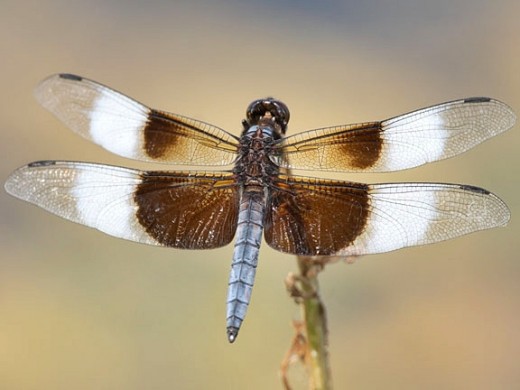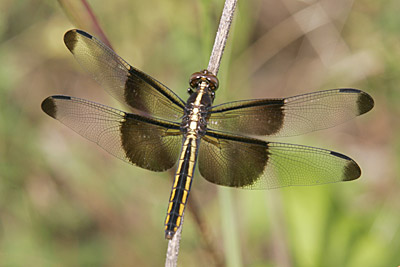- HubPages»
- Education and Science»
- Life Sciences»
- Entomology»
- Insects & Bugs
The Widow Skimmer Dragonfly
Mature Male Widow Skimmer

Widow Skimmer Dragonfly
The Widow Skimmer Dragonfly ( Libellula luctuosa ) is a large common insect seen from Spring to Autumn around ponds, lakes, creeks, marshes and watersheds. They may wander far from water to hunt and can be seen in yards and meadows. It is in a group of dragonflies known as King Skimmers. They are very commonly found all across the United States. However, they are not normally found in the higher areas of the Rocky Mountains in the United States and Canada or in southern Quebec and southern Ontario regions within Canada. Also, they are not found in the great Basin region of the United States. They only reached northern California in 1990. The species spread farther north than formerly known due to habitat alterations caused by humans.
The abdomens of mature male Widow Skimmers tend to be a steely blue color with dark areas that go to the base of the wings. Also, the abdomen on males will become lighter as the dragonfly ages. They have dark brown bands on the wings bordered by a distinctive outer band of white and then clear on the last 3rd of the wing. Females and immature males have brown abdomens with a yellow stripe running down each side. They have the brown bands on the wings but lack the outer white band. Females often have brown wing tips. The wingspan of Widow Skimmers is anywhere from 1 1/8 to 3 1/2 inches. The medium sized body is from 1 5/8 to 2 inches in length.
Appearance of Female and Immature Male

The male Widow Skimmers defend an area of approximately 250 square yards and may defend their favored perch.This dragonfly got its name because the male of this species leaves the female after the eggs have been laid. The male of most other dragonfly species stays near the female after she lays her eggs. The eggs are typically laid in ponds, wetlands or lakes. Nymphs are very light brown which makes them look similar to the leaves and sediment in the water. This helps to camouflage them from predators but also is helpful when waiting for tiny creatures to feed on. The Water Skimmer nymphs of these dragonflies have large eyes that help them to spot potential prey. The larvae, or nymphs, live in the water where they molt and grow until they are ready to emerge and then molt once more to reveal their wings. Most of a dragonfly’s life is spent in the larvae stage. Larger dragonfly species will live longer and may exist as nymphs for up to 4 years or more. The weather decides the life span but adult dragonflies typically live from 2 to 6 months.
Like other dragonflies, Widow Skimmers have excellent eyesight. Their compound eyes have up to 30,000 facets. Each of these is a separate light-sensing organ or ommatidium, which is arranged to give nearly a 360 degree field of vision. Dragonflies are also some of the fastest insects in the world. They are capable of reaching speeds of 19 to 38 mph. A study showed that dragonflies can travel as much as 85 miles in a day. Since they travel far and may be seen a distance from water then people often see them in their yards. I have seen Widow Skimmers and other dragonflies in my yard and in fields when hiking. Sometimes they are seen around bird baths and water gardens as well. However, they are harmless to humans. They do not sting or bite. Like spiders and other predators, dragonflies are beneficial. They help to maintain control of the insect population. They eat mosquitoes, ants, flies, wasps and other insects.
If you watch Widow Skimmers or other dragonflies then it is obvious that they are skilled flyers and sometimes entertaining to observe, especially for children. The males will spar and joust with each other while zipping through the air. This is when you can hear their wings clash. I watch this while in wetland areas every year. People don’t think about how long dragonflies have been around. Ancestors of present day dragonflies go back to carboniferous times. This means that the insects were flying around more than 300 million years ago. This time period predates dinosaurs and birds. Next time you see a dragonfly, whether it is a Widow Skimmer or another species, think about how ancient, beneficial, interesting, colorful and wondrous these amazing insects are.



